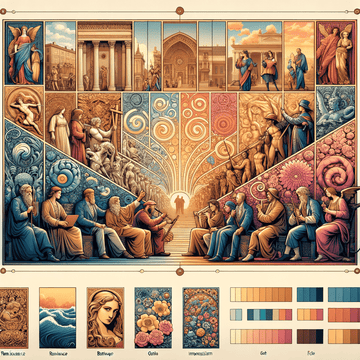Unveiling the Symbolism and Cultural Depth of Traditional Asian Art Styles: A Deep Dive into Chinese Landscape, Japanese Woodblock Prints, and Korean Folk Art
Apr 03, 2024

Exploring the Symbolism and Cultural Significance in Traditional Asian Art Styles
Asian art has a rich history that is deeply embedded in symbolism and cultural significance. Traditional Asian art styles, such as Chinese Landscape painting, Japanese woodblock prints, and Korean folk art, have captivated audiences for centuries with their unique aesthetics and storytelling elements. These art forms often feature intricate patterns, vibrant colors, and symbolic motifs that reflect the cultural beliefs and values of the artists.
Chinese Landscape painting, for example, is known for its depiction of nature, often featuring mountains, rivers, and trees. These landscapes are not just a representation of the physical world but also convey philosophical and spiritual ideas. Through the use of symbolism, such as the pine tree representing longevity or the lotus flower symbolizing purity, these paintings convey deeper meanings and evoke emotions in the viewer.
Japanese woodblock prints, on the other hand, are characterized by bold outlines and flat colors, influenced by the ukiyo-e style. These prints often depict scenes from everyday life, historical events, or famous myths and legends. Each element in the composition, from the clothing of the figures to the background settings, carries symbolic significance and cultural references that contribute to the narrative of the artwork.
Korean folk art, including Minhwa (Korean folk painting) and Najeonchilgi (mother-of-pearl inlay), showcases the traditional craftsmanship and artistic traditions of Korea. Minhwa paintings often feature animals, plants, and symbols that hold auspicious meanings, while Najeonchilgi art uses intricate patterns and inlaid designs to create decorative objects with symbolic significance.
By exploring these traditional Asian art styles, we can gain a deeper understanding of the cultural heritage and artistic traditions of the region. The symbolism and cultural significance embedded in these art forms serve as a window into the beliefs, values, and aesthetics of Asian cultures, providing a unique perspective on the world.
Interested in exploring more art like what we've discussed today? Our collection offers a diverse range of styles, including Chinese Landscape and beyond. Feel free to dive into our world of artistic wonders by visiting https://metalposterart.com/collections/chinese-landscape. Whether you're looking to admire or to acquire, there's always something captivating waiting for you. We're excited to share our passion for art with you.




